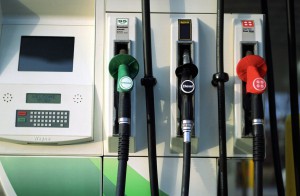The price of gasoline increased again this week, rising to $2.66 per gallon, which is the highest average price of the year, according to AAA. But the increases might be coming to an end as the rally that has lifted the price of crude oil runs out of steam.
Drivers are paying about four cents more per gallon than one week ago and 27 cents more per gallon than one month ago. However, relatively low crude costs continue to translate to significant savings at the pump for consumers. The national average is about a dollar less than a year ago and is at the cheapest level for this date since 2009, AAA said.
Month-over-month, the price has moved higher in every state and Washington, D.C. by a dime or more per gallon. Pump prices are up by a quarter or more in 22 states, with the largest monthly increases taking place in the western United States. Consumers in California at 61 cents per gallon, Nevada at 44 cents per gallon, Utah at 39 cents per gallon and Arizona at 39 cents have seen the largest increases over this period, due largely to the refinery issues in the region.
Rising averages are beginning to erode savings in a number of states. Prices are lower by a dollar or more in 30 states and Washington, D.C. year-over-year, which is 11 states fewer than one week ago. Consumers in Ohio where prices have dropped by $1.23, Michigan where prices are down by $1.18 per gallon and Kentucky where prices are down by $1.15 are saving the most per gallon compared to this same date last year.
The price of crude has moved higher since the middle of March due to slowing U.S. production, a weakening U.S. dollar and speculation of smaller demand growth from China.
Despite the price increase, many market watchers believe that the recent rally may be nearing an end due to oversupply continuing to characterize the global market, effectively putting a ceiling on how high the price can go.
The global oil cartel OPEC appears to be maintaining its strategy of high production levels and is scheduled to convene in June to reassess supply quotas, but in the meantime all eyes remain on U.S. production levels based on its new position as swing producer.
(Motorists watch fuel prices steadily climb upwards. For more, Click Here.)
In fact, OPEC has released a report this week that said crude prices will remain at roughly $75 per barrel for the foreseeable future.
The domestic benchmark WTI posted a weekly gain for the seventh consecutive week but remains significantly below the 2014 high of $107.95 per barrel. At the close of formal trading on the NYMEX, WTI settled 45 cents higher at $59.39 per barrel.
(Click Here for details on car owners getting a break on the cost of car ownership.)
AAA also predicts that automotive travel this Memorial Day holiday will be up 5.3% (33 million travelers) compared to last year’s holiday weekend, which would be the highest volume in ten years. Gas prices may not change all that much by the holiday weekend, which would result in the cheapest Memorial Day gas prices in at least five years.
California at $3.72 per gallon is the nation’s most expensive retail gasoline market, and is joined by four other states posting averages of $3 or more per gallon: Hawaii at $3.23, Nevada at $3.22, Alaska at $3.15 and Oregon $3 per gallon.
(To see more information about teenage driving accidents, Click Here.)
The price at the pump is above $2.50 per gallon in 36 states and Washington, D.C. On the other end of the spectrum, motorists in South Carolina at $2.37), Missouri at $2.39 and Mississippi at $2.40 are the paying the lowest averages at the pump, although they too have seen prices inch upward since last week’s report.


History has shown that the pump price does not always follow the wholesale price. The pump price may continue to increase because there is an industry monopoly and everyone enjoys increase profits from price gouging.
Shale production has supposedly stabilized but we’ll see for how long at the lower price per barrel which has shutter a number of shale oil companies or stopped production.
You’re right Jorge. But don’t forget in the next week or so there will be the auto-bump for “summer driving season”, a la Memorial Day weekend. This, despite the fact there are many reports people are flying more than driving.
The WTI increases really have been forced but can’t continue to do that because of not-so-bad news; meaning there hasn’t been any ME pipeline attacks or other supply distractions and they can’t keep replaying the refinery stories overand over…
Consumers and many in the media are gullible or shills.
No need to worry about pipeline attacks, as we have the annual “refinery fires/shut downs/ explosions to artificially inflate pump prices when wholesale prices are still relatively low.